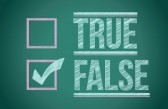I am going to make headway on the series of very short articles or tidbits on Transaction SQL Operators. An operator is a symbol specifying an action that is performed on one or more expressions. I will exploring the Logical Operators today. In short, these operators return either a boolean TRUE or FALSE. To demonstrate many of these operators, we need a temporary table to query against. The Transaction SQL code below creates a table that contains the first eight prime numbers. Any complex real world programming example probably has…
Tag: EXISTS
Searching Stored SQL – Part 4
There are four main database objects that contain stored SQL: VIEWS, TRIGGERS, FUNCTIONS and STORED PROCEDURES. Earlier today, I created a pattern searching tool for FUNCTIONS. I am going to clone and modify the code so that it will work with VIEWS. Again, I want to examine the dynamic SELECT statement that retrieves the user defined stored procedure names from a given database. This is the key element of the whole program. I took the liberty to modify the original code so that it will work standalone. The current code…
Searching Stored SQL – Part 3
There are four main database objects that contain stored SQL: VIEWS, TRIGGERS, FUNCTIONS and STORED PROCEDURES. Yesterday, I created a pattern searching tool for TRIGGERS. Today, I am going to clone and modify the code so that it will work with FUNCTIONS. Again, I want to examine the dynamic SELECT statement that retrieves the user defined stored procedure names from a given database. This is the key element of the whole program. I took the liberty to modify the original code so that it will work standalone. The current code…
Searching Stored SQL – Part 2
There are four main database objects that contain stored (compiled) SQL: VIEWS, TRIGGERS, FUNCTIONS and STORED PROCEDURES. Yesterday, I created a pattern searching tool for SQL code in STORED PROCEDURES. Today, I am going to clone and modify the code so that it will allow pattern searching on TRIGGERS. First, I want to examine the dynamic SELECT statement that retrieves the user defined stored procedure names from a given database. This is the key element of the whole program. I took the liberty to modify the original code so that…
Searching Stored SQL – Part 1
Today, I am going to start building on some the articles I did in the past. We are going to create tools to pattern search stored SQL statements. Four main objects that contain stored SQL are VIEWS, TRIGGERS, FUNCTIONS and STORED PROCEDURES. Recently at work, I was asked to find all SQL code that had a certain business rule. The task is to return all objects that reference to a certain temperature process named T1. One solution to this problem is to buy a tool like SQL Search from Red…
Temporary Tables – Part 2
Today, I am going to talk about local and global temporary tables. A local temporary table is defined by using the CREATE TABLE syntax with the name of the table prefixed by one number sign #. The scope of the local temporary table is the current session or SPID. A global temporary table is defined by using the CREATE TABLE syntax with the name of the table prefixed by two number signs ##. The table is visible to all sessions. The scope of the global temporary table is the current…
Selecting Data – Part 4
Today, I am continuing our exploration of the SELECT reserved word by talking about sub-queries. A sub-query is a query that is nested inside a SELECT, INSERT, UPDATE, or DELETE statement, or inside another sub-query. Sub-queries can be used anywhere an expression is allowed or can be nested inside another sub-query. I will be using the AdventureWorks Sample database supplied by Microsoft during this talk.
|
1 2 3 4 |
<span style="color: #008000; font-family: Lucida Console; font-size: small;">-- Use the correct database USE AdventureWorks2008R2 GO </span> |
One usage a sub-query is with comparison operators in the where clause. The example below returns all the sales people by name and id…
